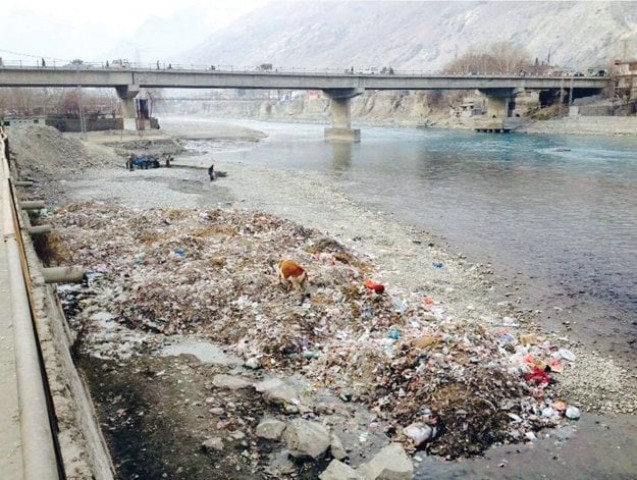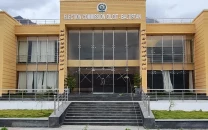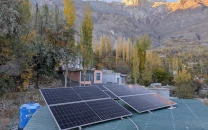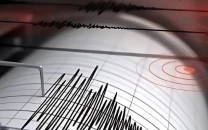A tall drink of sewage: Purest at the source? Think again
Gilgit River water a reservoir of faecal content, Salmonella, chemical waste

Gilgit River water a reservoir of faecal content, Salmonella, chemical waste. PHOTO: NAZAKAT ALI
Think Gilgit, and you think fresh springs, glaciers and snow-capped peaks. The region is a mountain climber’s heaven, and every visitor’s ‘I’m an insta-photographer’ moment. But for the people who live there, it’s all about scraping below the surface.
Piles of garbage, sewerage lines and car washes – these are the manmade landmarks on the banks of Gilgit River. A river which gives thousands of people drinking water in Gilgit city, the capital of Gilgit-Baltistan.
Dirty business: Winter brings sewage out on city’s streets
The water is used by over 10,000 residents in areas including Cheeta Colony, NLI Colony, Noor Colony and Zulfiqarabad. A water uplift project introduced by Water and Sanitation Extension Programme (WASEP), a non-governmental organisation, helps the sprawling population meet its requirements through the river. A couple of pumps have also been installed at the bank by the government but these are less productive.
The good work done by NGOs has been undermined by the rising levels of pollution and contamination at the hands of the public which is aided by the government’s lack of action.
On the River View Road side, the banks transform into the local car wash where dozens of vehicles line up to get their shine on. Filth and chemicals from vehicles is washed off and into Gilgit River morning to evening daily. If gasoline, engine oil and grease were not enough to add to the hazard level of the ‘fresh’ water; the same side also sees sewerage lines dump right into the river. These come straight from car service centres and residential areas.
Towards the University Road side of Gilgit River, the banks become the local government’s landfill. Tractors loaded with garbage—which also contains hospital waste—can been seen lining the river with what experts consider to be toxic waste. To make matters worse, the garbage is often also set on fire. After the biodegradables turn to ash, the melted and coagulated plastics and aluminium remains end up flowing into the river.This is the water which is ultimately used by millions downstream as far as Attock in Punjab.
Getting wasted
According to Farasat Ali of World Wildlife Fund, Gilgit city generates around 55 to 60 tonnes of solid waste daily. This is disposed of in an unscientific way by the Gilgit Municipal Committee.
With this much solid waste in the water considered potable, does the river allow some run-off or natural filtering to leave it safe for human consumption?
Experts respond with a big, “No”. The water is hazardous for human health, they say.
“[It] is highly contaminated,” said Maisoor Ahmed Nafees, an assistant professor at Karakoram International University. “We have tested several samples of the water in the recent past only to find it highly unfit for human consumption,” said Ahmed.
Nafees is also the administrator of the state-of-the-art laboratory established through the Italian government’s Social Economic Environment Development (SEED). The water laboratory at KIU was funded through the non-profit association EV-K2-CNR.
According to Nafees, studies were conducted by KIU from December 2014 to July 2015 to evaluate the effect of major drains emptying directly into Gilgit River within municipal limits. “The main contributing drains/ points transferring highest bacterial load to river are the slaughter house, Konodass Bridge, twin bridges, Chinarbagh area in the limits of municipality,” he shared in a follow-up email to The Express Tribune.
What’s in the water?
To judge the impact of liquid waste on river water quality, samples were taken before and after drains would empty into Gilgit River. These were investigated for bacteria and chemical parameters at the lab at KIU.
“The picture painted by the results was pathetic,” said Nafees. “There was a very high level of bacterial contamination.”
So what did they find lurking behind picturesque, sparkling aqua? Pathogenic bacteria.
Salmonella and Shigella (which is closely related to Salmonella) were present in almost all samples.
In the paper The Global Burden of Nontyphoidal Salmonella Gastroenteritis (Majowicz et al., 2010), the authors did a meta-analysis and estimated 155,000 deaths could be attributed by gastroenteritis caused by Salmonella. Since this is an estimate based on existing global and not specific data, there is no telling exactly how many of those fatalities are from Pakistan. However, a study on dehydrating gastroenteritis in Pakistani children published in 2015 in the journal Viruses, attributes 74,000 deaths to diarrhoea – which is a severe symptom of both bacteria.

Back to the samples – indicator organisms which are used to monitor conditions of a particular environment also revealed contamination in Gilgit River. E.coli bacteria were present, an indicator for faecal contamination and an index organism indicating the presence of pathogens such as Salmonella. Enterococcus bacteria were also found – which can cause a host of other infections and is antibiotic resistant.
“Enterococci and E.coli bacteria were too numerous to count in a sample of 100ml; the World Health Organization standard is 0 in a 100ml,” said Nafees in his follow-up email to The Express Tribune. “This water is being consumed by a majority of Gilgit city inhabitants directly or from uplift pumps along the river [banks].”
The increased rate of phosphates was recorded by the researchers as yet another indication of high amounts of waste. Without going into more complicated details, excessive phosphates can lead to increase in toxic algae and decrease in biodiversity – also noted in the study as the reduction of fish in the last seven to eight years.
Unfit for human consumption
The studies concluded consumers of the river water were extremely vulnerable to “water-borne diseases” and the water was “unfit for human consumption”. It recommended more investigation on contamination as well as the need for a proper sewerage system and waste-water treatment plants.
Mark Giordano, the Cinco Hermanos Chair in Environment and International Affairs, is an associate professor at Georgetown University in Washington DC.
Giordano told The Express Tribune over email, “Gilgit River flows directly into the Indus, so most of what gets dumped into the Gilgit will end up in the Indus.”
He said, “Human waste is not likely to be a major issue for agriculture and may not be for drinking water if the water is properly treated by filters and/or boiling.” Giordano added, “Even if it can be treated though, dumping sewage into a clean drinking water supply only so you have to treat the water later is at best an example of poor planning and at worst immoral. It happens in many places, but it shouldn’t.”
The associate professor was more concerned over the impact on drinking water from hospital waste and mechanics shops.
“I doubt any filter would properly deal with some of the chemicals, and boiling is not likely to be useful (boiling works to kill microbes, generally it will not help with chemical pollutants). Potential impacts on agriculture are probably small. It is impacts on human health I would be concerned with.”
Indus River System Authority (IRSA) Director Operations and Spokesperson Khalid Adrees Rana agreed with Giordano; the contamination will not harm agriculture as much. “The impact won’t carry so far because the river is diluted by others, then enters Tarbela Dam where it will be further diluted,” he told The Express Tribune over the telephone.
However, Rana was clear about its impact on people. “Where people use it as drinking water, it is very harmful.”
Problems unheard
The Environmental Protection Agency (EPA) regional office has stepped in many times in the past but with little success.
“We have written many letters over the past four or five years to respective chief secretaries informing them of repercussions of these unhealthy practices,” Khadim Hussain, an assistant director at EPA, told The Express Tribune. “On our interference, Section 144 has been imposed against car washing and the construction of car wash centres near the river but implementation is the job of the government.”
He said Chilmis Das was identified as a suitable place in the peripheries of Gilgit to dump solid waste. “Let’s hope its use begins soon.”
Aslam Khan who lives in Zulfiqar Colony knows drinking the water is like drinking from a toilet bowl, but “we have no choice but to use it,” he added.
“This is the water we use daily,” he said. “We know it is polluted – badly polluted. The waste from the entire city is thrown in there but we have no other choice but to use it,” said Aslam. “We all would have died of waterborne diseases had we not arranged our own water purification systems at homes.”
Some people boil the water before using it while others like Asalm have set up domestic filter plants. Unfortunately, a large population drinks the water as it is. And they end up spending whatever little money they have on their health.
“My two-year-old son falls ill frequently,” said Barkat Ali, another resident of Zulfiqar Colony. “He complains of stomach pains. Doctors ask me to use boiled water but that’s not possible all the time.”
Ali runs a small shop. “In November, I had to close my shop to get my child checked by doctors. And then there was the cost of his medication.” A couple of companies have expanded their businesses in the city, selling unbranded filtration plants. Aware that their customers are not familiar with branded products, they are cashing in on the opportunity.
The great divide: Floodwater outside, no drinking water inside
Mechanics and car owners also continue to make use of the freely-available river water without realising—or accepting—the danger associated with water contamination. “This is an easy solution,” said one car driver. “It helps me save time and money and I think washing my car [in the river] doesn’t make a difference for water health.”
Land of glaciers
Glaciers in Pakistan constitute the biggest mass and collection of glaciated ice found anywhere in the whole world outside the North and South poles. These glaciers are heavily concentrated in the three great mountain ranges of Karakoram, Himalaya and Hindu Kush, situated in the northern regions of Gilgit-Baltistan and Chitral in Khyber-Pakhtunkhwa.
Published in The Express Tribune, February 15th, 2016.



















COMMENTS
Comments are moderated and generally will be posted if they are on-topic and not abusive.
For more information, please see our Comments FAQ